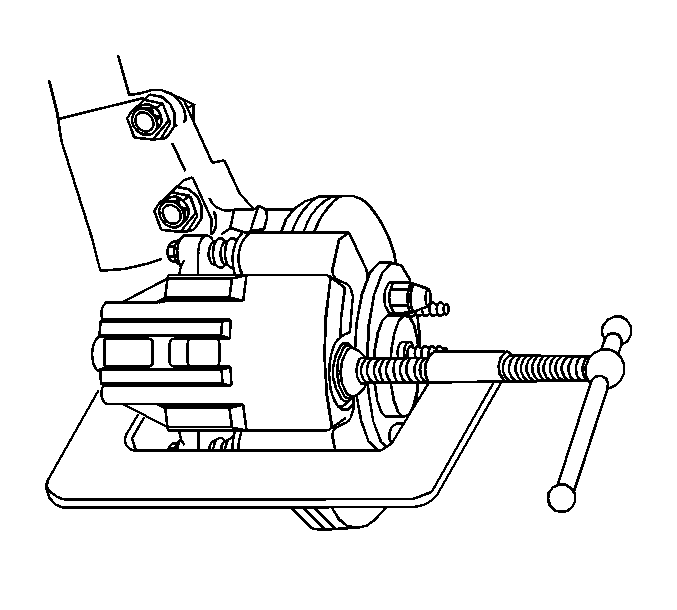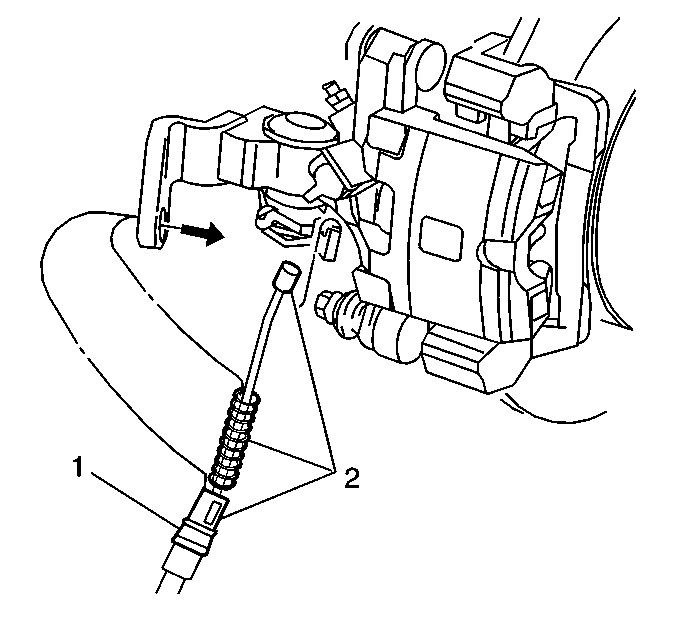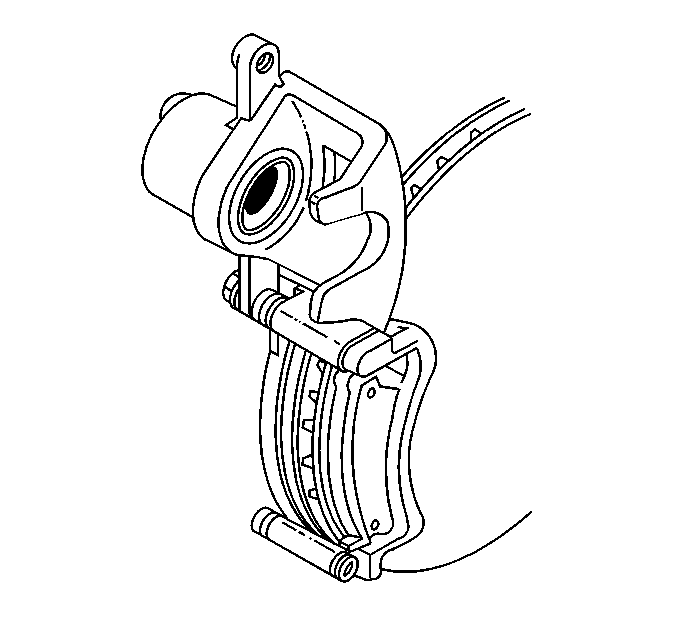Rear Brake Caliper Replacement Without J55
Removal Procedure
- Remove two-thirds of the brake fluid from the master cylinder.
- Raise the vehicle and suitably support. Refer to Lifting and Jacking the Vehicle in General Information.
- Remove the wheel and tire assembly. Refer to Tire and Wheel Removal and Installation in Tires and Wheels.
- Using a large C clamp compress the caliper piston into the caliper bore to gain enough clearance to allow the caliper to pivot off the caliper bracket. Compress the piston until resistance is felt, but no more than 1 mm of piston travel.
- Remove the C-clamp from the brake caliper.
- If the brake caliper is to be removed for repair, remove the brake caliper inlet fitting to the brake caliper, and plug the opening in the brake caliper and brake hose to prevent fluid loss and contamination.
- Disconnect the wheel speed sensor retainer clip and move out of the way.
- Remove the park brake cable bracket bolt.
- Disconnect the park brake cable (1) from the brake caliper.
- Remove the lower brake caliper pin bolt.
- Rotate the brake caliper upward.
- Slide the brake caliper off the upper pin bolt to remove.
Important: Do not use a screwdriver or pry bar to compress the caliper piston into the caliper. Any damage to the piston boot could cause corrosive elements to enter the piston sealing area and lead to the piston seizing in the caliper bore.
Important: Do not exceed more than 1 mm of piston travel. Damage to the internal adjusting mechanism may result.



Installation Procedure
- Slide the brake caliper onto the top brake caliper pin bolt.
- Pivot the brake caliper (6) down over the brake pads and onto the caliper bracket (5).
- Install the lower brake caliper pin bolt.
- Install the brake hose inlet fitting to the brake caliper.
- Install the park brake cable (1) to the brake caliper.
- Install the park brake cable bracket to the caliper.
- Install the park brake cable bracket bolt.
- Bleed the brake system. Refer to Hydraulic Brake System Bleeding in Hydraulic Brakes.
- Start the vehicle and apply approximately 778 N·m (175 lb. ft.) of force three times to seat the brake caliper piston and the brake pads.
- Recheck the brake fluid. Refer to Master Cylinder Reservoir Filling in Hydraulic Brakes.
- Install the tire and wheel assembly. Refer to Tire and Wheel Removal and Installation in Tires and Wheels.
- Lower the vehicle.

Important: The brake caliper piston cutouts must be aligned with the locating pins on the brake pad.
Notice: Use the correct fastener in the correct location. Replacement fasteners must be the correct part number for that application. Fasteners requiring replacement or fasteners requiring the use of thread locking compound or sealant are identified in the service procedure. Do not use paints, lubricants, or corrosion inhibitors on fasteners or fastener joint surfaces unless specified. These coatings affect fastener torque and joint clamping force and may damage the fastener. Use the correct tightening sequence and specifications when installing fasteners in order to avoid damage to parts and systems.
Tighten
Tighten the brake caliper pin bolt to 26 N·m (20 lb ft).

Tighten
Tighten the brake hose fitting bolt to 45 N·m (33 lb ft).

Tighten
Tighten the park brake cable bracket bolt to 43 N·m (32 lb ft).
Rear Brake Caliper Replacement J55
Removal Procedure
- Inspect the fluid level in the brake master cylinder reservoir.
- If the brake fluid level is midway between the maximum-full point and the minimum allowable level, no brake fluid needs to be removed from the reservoir before proceeding.
- If the brake fluid level is higher than midway between the maximum-full point and the minimum allowable level, remove brake fluid to the midway point before proceeding.
- Raise the vehicle and suitably support. Refer to Lifting and Jacking the Vehicle in General Information.
- Remove the tire and wheel assembly. Refer to Tire and Wheel Removal and Installation in Tires and Wheels.
- Install a large C-clamp over the top of the brake caliper housing and against the back of the outboard brake pad.
- Install a large C-clamp over the top of the caliper housing and against back of the outboard brake pad.
- Compress the brake caliper piston into brake caliper bore to allow the piston enough clearance to slide the brake caliper off the brake rotor.
- Remove the C-clamp from the brake caliper.
- Remove the brake hose to caliper bolt and plug the opening in the brake caliper and brake hose to prevent fluid loss and contamination.
- Remove the brake hose from the brake caliper.
- Remove and discard the 2 copper brake hose gaskets. These gaskets may be stuck to the brake caliper and/or the brake hose end.
- Remove the brake caliper pin bolts.
- Remove the brake caliper.



Installation Procedure
- If reusing the brake caliper retainers and sleeves, clean the sleeves using denatured alcohol, or equivalent.
- Apply a thin coat of hi temperature silicone lube to the brake caliper retainers and sleeves.
- Install the brake caliper over the brake pads and into the brake caliper bracket.
- Install the brake caliper pin bolts.
- Remove the plugs in the brake hose end.
- Assemble the brake hose bolt and the NEW copper brake hose gaskets to the brake hose.
- Install the brake hose to caliper bolt to the brake caliper.
- Bleed the brake system. Refer to Hydraulic Brake System Bleeding .
- With the engine OFF, gradually apply the brake pedal to approximately 2/3 of its travel distance.
- Slowly release the brake pedal.
- Wait 15 seconds, then repeat steps 9-10 until a firm brake pedal apply is obtained; this will properly seat the brake caliper pistons and brake pads.
- Install the tire and wheel assembly. Refer to Tire and Wheel Removal and Installation in Tires and Wheels.
- Lower the vehicle.

Notice: Use the correct fastener in the correct location. Replacement fasteners must be the correct part number for that application. Fasteners requiring replacement or fasteners requiring the use of thread locking compound or sealant are identified in the service procedure. Do not use paints, lubricants, or corrosion inhibitors on fasteners or fastener joint surfaces unless specified. These coatings affect fastener torque and joint clamping force and may damage the fastener. Use the correct tightening sequence and specifications when installing fasteners in order to avoid damage to parts and systems.

Tighten
Tighten the brake caliper pin bolts to 31 N·m (23 lb ft).
Important: Install NEW copper brake hose gaskets.

Tighten
Tighten the brake hose to caliper bolt to 45 N·m (33 lb ft).
